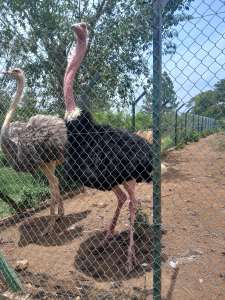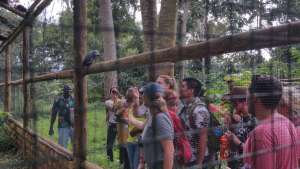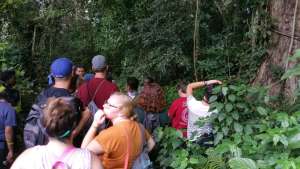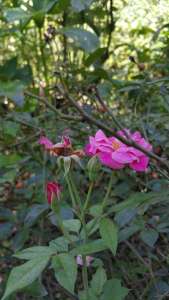[vc_row][vc_column icons_position=”left”][vc_column_text css_animation=”fadeInUpBig”] Extermination of species has passed as a natural process since life began on Earth, but mortal conditioning has greatly accelerated the rate of extermination in recent times. Among the numerous factors that may contribute to the exposure of a species are niche destruction, over-exploitation, the preface of fantastic species, and climate change. Exposed creatures face extermination in all or a part of their ranges unless specific measures are taken for their protection. Threatened creatures are likely to come risked in the near future. Exposed mammals and catcalls have entered the topmost quantum of attention in conservation sweats to date, but there is a growing recognition of the significance of risked amphibians, reptiles, fish, and pets, so these creatures are likely to admit further attention in the future. Although shops are essential to mortal and carnal life, risked shops have entered little attention compared with that given to risked creatures.
Extermination of species has passed as a natural process since life began on Earth, but mortal conditioning has greatly accelerated the rate of extermination in recent times. Among the numerous factors that may contribute to the exposure of a species are niche destruction, over-exploitation, the preface of fantastic species, and climate change. Exposed creatures face extermination in all or a part of their ranges unless specific measures are taken for their protection. Threatened creatures are likely to come risked in the near future. Exposed mammals and catcalls have entered the topmost quantum of attention in conservation sweats to date, but there is a growing recognition of the significance of risked amphibians, reptiles, fish, and pets, so these creatures are likely to admit further attention in the future. Although shops are essential to mortal and carnal life, risked shops have entered little attention compared with that given to risked creatures.
This Conservation of endangered and rare animal and plant species is intended to serve wide exploration followership, as well as to give useful, quality information and exploration backing to the interested public across the globe. This companion is not a total list of coffers, but rather a starting point for probing risked and hovered species.
From majestic birds like ostriches and horrible parrots to wildflowers, and herbal medicine, Uganda harbours a remarkable array of birds, plants and primate species.
Unfortunately numerous of our species have not fared well over the once many decades, suffering from pitfalls similar to niche loss and the spread of invasive species.
Scientists estimate that up to one-third of Species are at increased threat of extermination, and further than,600U.S. shops and creatures formerly have been federally listed as hovered or risked and defended under the Exposed Species Act.
The Uganda Wildlife Authority has long concentrated on guarding the most vulnerable of our wild species at the Entebbe Zoo and it also encourages other private stakeholders like Chakig Echo-Tourism Centre to preserve and conserve nature.
Our Approach
Traditionally world over, animals were kept in zoos for the purpose of only human entertainment, and there was little commitment to animal welfare standards. Assessing the role of zoos in wildlife conservation. As the public’s attitude towards the use of animals has changed, many conservations have responded by moving away from entertainment and toward conservation. The public face of zoos: Images of entertainment, education and conservation. Alongside this transformation came an increased focus on animal welfare. This focus has resulted in an intensification of zoo-based science dedicated to;
(a) Evaluating the success of conservation aims.
(b) The impact of the zoo environment on animal behaviour and welfare. How does the zoo environment affect the behaviour of captive primates?
This focus on empirical operating philosophies for zoos has led to the development of zoo animal welfare science as a specialization within the broader field of welfare science.
 Research is an integral component of successful zoo-based conservation. CETC is committed to conducting quality research that provides opportunities for scholars involved in wildlife research using our facilities to conduct ex-situ research.
Research is an integral component of successful zoo-based conservation. CETC is committed to conducting quality research that provides opportunities for scholars involved in wildlife research using our facilities to conduct ex-situ research.
Researching captive animals increases our knowledge of their care and biology, which may not be possible in the wild. CETC is home to more than 1000 herbal plant animals from nearly 5 species many of which are endangered in the wild and in conservation breeding programmes. Many of the animals were injured, confiscated or orphaned. There are a variety of animals, which include; Hoof storks, Primates, Birds, and Reptiles
CETC has breeding programmes aimed at preserving threatened species and creating stable populations. These involve capture and release, multiplication and free-ranging.
We support research, which improves animal welfare and health that promote conservation. We are committed to supporting high-quality research at all levels from high school projects to post-doctorate theses. Our research facilities include a library, computers with standard software, internet access, access to zoo animal records and a database of zoo-specific documents
Our focus is on applied research that has tangible outcomes for the following key thematic areas:
- Captive breeding of threatened species and re-introduction
- Animal Health and well-being
- Reproductive management and collection sustainability
- Mitigation of key threatening processes
- Community conservation and visitor engagement
CETC will continue to identify and develop specific research projects that address key knowledge gaps and aim to improve our conservation and animal care activities.
We have a Projects and Research Committee those coordinates the research projects, including research conducted at our premises, in the field, and in partnership with other research organizations. Our Onsite and Outreach Conservation team also engages in research that allows us to increase the effectiveness of our behaviour change campaigns, visitor experiences and education goals.
CETC welcomes research proposals from external organisations (e.g. universities, government agencies and other zoos). All proposals are evaluated against a set of criteria to determine their alignment with our research and organisational priorities with approval dependent on feasibility, resources and animal welfare and ethical considerations.
The Centre specializes in the provision of Eco tourism interpretive activities to both domestic and international visitors.
At our premier Eco-tourism facility, enjoy and learn how we contribute to climate change research, learn about the medicinal values of a variety of plants, and how we promote a sustainable living model in Uganda through trickling and applying these practical hands-on models with neighbouring communities.
Defending and strengthening the Exposed Species Act, which provides an essential legal safety net to help the loss of factory and beast species to extermination.
Holding Civil agencies and others responsible for complying with laws guarding rare and exposed species using cooperation, persuasion, and where necessary — action.
Championing for increased backing for civil and state conservation programs that profit exposed species.
Guarding, restoring, connecting the territories on which exposed species and other wildlife depend for their survival, and encouraging wildlife-friendly land operation practices.
Reducing pitfalls to wildlife that can lead to their endangerment and extermination, similar as loss of niche, impurity of water and spread of invasive species.
State Wildlife Action Plans
One of the stylish ways to cover exposed species is to help their decline and deterioration in the first place. Toward that end, National Wildlife Federation works to maintain healthy populations of fish, wildlife, and factory species through promoting broad-grounded conservation sweats similar to State Wildlife Action Plans. National Wildlife Federation is championing for passage of the Recovering America’s Wildlife Act, which is a bold new approach for furnishing the backing demanded to carry out these visionary conservation plans.
Climate Change
 Climate change is making the protection of exposed species decreasingly gruelling. Climate change not only affects our shops and creatures directly — through changes in temperature and rush for case — but can worsen the impact on exposed species of traditional pitfalls, similar as invasive species, backfires and conditions.
Climate change is making the protection of exposed species decreasingly gruelling. Climate change not only affects our shops and creatures directly — through changes in temperature and rush for case — but can worsen the impact on exposed species of traditional pitfalls, similar as invasive species, backfires and conditions.
The National Wildlife Federation is playing a leading part in developing and promoting innovative approaches for climate-smart conservation that can guard exposed species and other wildlife in the face of a changing climate.
Guarding Exposed Species
Still Only One Earth Assignments from 50 times of UN sustainable development policy
 Despite continued conservation sweats, the status of numerous exposed species remains unchanged. The Convention on International Trade in Endangered Species of Wild Fauna and Flora (CITES) and the Convention on Migrant Species of Wild Creators (CMS) are the primary covenants assigned to the protection of exposed species. However, moving forward, species conservation sweats should expand to include lower known species that serve important ecosystem services.[/vc_column_text][/vc_column][/vc_row]
Despite continued conservation sweats, the status of numerous exposed species remains unchanged. The Convention on International Trade in Endangered Species of Wild Fauna and Flora (CITES) and the Convention on Migrant Species of Wild Creators (CMS) are the primary covenants assigned to the protection of exposed species. However, moving forward, species conservation sweats should expand to include lower known species that serve important ecosystem services.[/vc_column_text][/vc_column][/vc_row]
